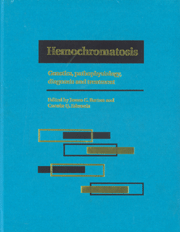Book contents
- Frontmatter
- Contents
- List of contributors
- Foreword
- Part I Introduction to hemochromatosis
- Part II Genetics of hemochromatosis
- Part III Metal absorption and metabolism in hemochromatosis
- Part IV Diagnostic techniques for iron overload
- Part V Complications of iron overload
- Part VI Therapy of hemochromatosis and iron overload
- Part VII Infections and immunity in hemochromatosis
- Part VIII Hemochromatosis heterozygotes
- Part IX Relationship of hemochromatosis to other disorders
- Part X Animal models of hemochromatosis and iron overload
- Part XI Screening for hemochromatosis
- 50 Screening tests for hemochromatosis
- 51 Cost-effectiveness of screening for hemochromatosis
- Part XII Hemochromatosis: societal and ethical issues
- Part XIII Final issues
- Index
50 - Screening tests for hemochromatosis
from Part XI - Screening for hemochromatosis
Published online by Cambridge University Press: 05 August 2011
- Frontmatter
- Contents
- List of contributors
- Foreword
- Part I Introduction to hemochromatosis
- Part II Genetics of hemochromatosis
- Part III Metal absorption and metabolism in hemochromatosis
- Part IV Diagnostic techniques for iron overload
- Part V Complications of iron overload
- Part VI Therapy of hemochromatosis and iron overload
- Part VII Infections and immunity in hemochromatosis
- Part VIII Hemochromatosis heterozygotes
- Part IX Relationship of hemochromatosis to other disorders
- Part X Animal models of hemochromatosis and iron overload
- Part XI Screening for hemochromatosis
- 50 Screening tests for hemochromatosis
- 51 Cost-effectiveness of screening for hemochromatosis
- Part XII Hemochromatosis: societal and ethical issues
- Part XIII Final issues
- Index
Summary
Introduction
Tests to identify occult hemochromatosis must be considered in the context of accepted practices for screening laboratory programs and have thoughtful goals and evaluation procedures to yield acceptable outcomes for both screen-positive and screen-negative individuals.
The clinical course of hemochromatosis (Fig. 50.1) is consistent with the recommendations of the World Health Organization and others for conditions appropriate for screening programs. Hemochromatosis is prevalent (at least 5 per 1000) and has a prolonged presymptomatic phase. Treatment during the early phase prevents future organ failure and restores the length and quality of life to match that of unaffected controls. The total burden of illness is not precisely known. Data suggest that 50% of male and 10% of female homozygotes will develop serious symptoms. Therefore, the burden of ilness is high enough to warrant medical and public attention. The costs of testing and preventative treatment are favorable compared to awaiting the development of symptoms.
Why has there been no widespread, publicly supported screening program for hemochromatosis? Three explanations seem plausible. First, the burden of illness is neither obvious to the general public nor completely documented by medical science. Second, hemochromatosis has not yet been shown to cause or have the potential to generate a high dollar volume in either diagnostic testing or sale of therapeutic drugs. Finally, the evidence regarding costeffectiveness for early detection and treatment of hemochromatosis has not been understood in the context of other disease care or wellness interventions.
- Type
- Chapter
- Information
- HemochromatosisGenetics, Pathophysiology, Diagnosis and Treatment, pp. 519 - 524Publisher: Cambridge University PressPrint publication year: 2000
- 1
- Cited by



